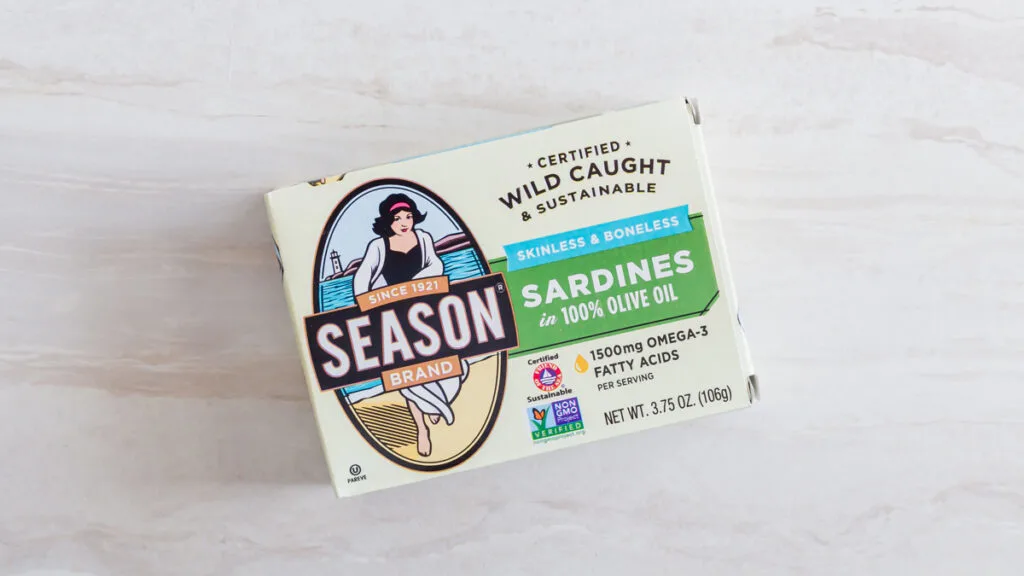Sardines may be little in size but they sure pack a big punch nutritionally speaking. Maybe you already enjoy these fatty little fish regularly yourself or perhaps you’re just looking for a way to get rid of some cans of sardines that’ve been hiding out in the pantry for awhile.
Either way, can dogs eat sardines? The answer is yes!
Adding sardines to your dog’s diet can bring a wonderful array of health benefits.

NUTRITIONAL VALUE OF SARDINES
Unlike bologna, sardines are a great source of protein with an impressive omega-3 fatty acids profile.
The two primary omega-3 fats found in sardines are EPA (eicosapentaenoic acid) and DHA (docosahexaenoic acid). These are the same healthy fats found in many fish oil supplements.
An average can of sardines contains about 1,800mg of EPA and DHA combined.
They’re also a good source of coenzyme q10 (CoQ10), vitamin B12 and even one of the few natural food sources of vitamin D.
DO SARDINES CONTAIN HARMFUL MERCURY?
Sardines are very small fish and the easiest way to think of mercury contamination in fish is the bigger the fish, the higher the likelihood of mercury or other heavy metals.
The way fish accumulate mercury is by eating other fish. Since sardines are low on the ocean totem pole and feed on plankton rather than other fish, they don’t have the high mercury levels that larger fish like tuna or swordfish are known for. Heavy metal accumulation is also one of the reasons why fish sticks aren’t a great food choice for dogs — among other reasons.
They also simply don’t live long enough for any other toxins they may come in contact with to make a significant impact.
Therefore, sardines and other oily fish like wild-caught salmon, mackerel and herring are some of the healthiest choices for getting omega-3s in your diet whether you’re human or canine!
HEALTH BENEFITS OF SARDINES FOR DOGS
Besides the obvious of providing a wonderful natural source of omega-3s for your dog, sardines have a handful of other great benefits for your dog’s health too.
SKIN & COAT
You’ve probably seen fish oil supplements in a liquid pump form sold at the pet store and most people buy them to help improve their dog’s coat health. It’s true, those aforementioned healthy omega-3s can do wonders to promote healthy skin and a shiny coat for your pup!
This can especially be true for dogs that suffer from allergies, hot spots or seasonal itchiness/dryness. If you don’t want to buy one of those (oftentimes expensive) pumps from the pet store, whole canned or fresh sardines are a great alternative.
JOINT PAIN
If your furry friend suffers from joint pain or arthritis, once again the natural oils found in sardines have been shown to contain anti-inflammatory properties and help mitigate inflammation.
Sardines with the soft bones intact also offer a good source of calcium which we know is essential in maintaining strong bones.
For both these reasons, sardines or a fish oil supplement is often recommended as a dog ages and/or for very active canines like service dogs.
COGNITIVE FUNCTION
DHA specifically is incredibly important for brain development and function. Plentiful DHA has been associated with improved learning ability.
Making sure your dog, especially a puppy, has enough of this essential fat is important.
IMMUNE & HEART HEALTH
CoQ10 is an antioxidant found in sardines. It has been shown to support the heart, the neurological system and can even be beneficial to your dog’s immune system.

CANNED VS. FRESH SARDINES
Both types of sardines are safe to feed a dog. Since it may be harder to come by the fresh whole fish, we often default to the canned variety.
There are a few things to consider, however, with canned sardines, particularly what they’re packed in.
Most tinned sardines come in either water or oil.
If packed in water, there’s nothing to be concerned with. Water packed sardines are totally safe for dogs so long as the only ingredient is the sardines themselves.
Oil packed sardines warrant a heads up. Look for sardines packed in olive oil.
Olive oil is another heart healthy oil with a good fatty acid composition whereas lower quality oils like sunflower oil are much more heavily skewed towards the omega-6 fatty acids.
It’s also important to look out for any added flavoring ingredients (herbs, salt, garlic, etc.) as those should be avoided when giving your dog sardines.
If choosing the oil packed variety, drain as much of the oil from the can before feeding to your dog. The sardines themselves contain enough fat. The added oil is unnecessary and can even cause a bit of digestive distress for your pup.
Sometimes sardines can be found packed in tomato sauce. It’s best to avoid this variety when giving to your dog as the ingredients used to make the tomato sauce could be potentially dangerous to their health.
Smoked sardines, like smoked salmon, are also something to avoid. The smoking process adds unnecessary salt that your dog does not need. When feeding both sardines and salmon, it’s best to stick with plain, unseasoned and unsmoked options.
CAN DOGS EAT SARDINES WITH BONES?
Some canned sardines are sold whole with the bones intact while others may be skinless and boneless. The good news is both types are safe to feed your dog.
Canned sardine bones (as opposed to something like pork rib bones) are softened from the pressure cooking process and totally safe for consumption.
As mentioned above, the fish bones actually provide a good source of calcium and phosphorous for your dog as well.
If you have access to fresh sardines, those bones may be harder and it’s best to debone the fish before giving your dog to avoid any potential choking hazards.

SERVING SIZE OF SARDINES FOR DOGS
As with all food, the serving size will vary depending on the size of your dog. Large breeds will be able to consume a much higher quantity of sardines than a teacup sized dog.
Start slowly with small portions when introducing sardines for the first time recognizing they’re a calorie dense, high-fat food.
Because half the calories in sardines come from fat (the other from protein), too much too fast can result in stomach upset or unintended weight gain from the additional fat.
WEEKLY FEEDING AMOUNTS:
- For dogs 5-15 pounds: 1/4-1/2 can
- For dogs 16-50 pounds: up to 3/4 can
- For dogs 51- 1 to 1 1/2 cans
Remember, while sardines may be your whole meal, for a dog they’re a delicacy. Never feed more than 10% of your dog’s total calories from food outside their normal diet. Treat sardines as a supplement to their diet rather than the main component even though they are a healthy source of protein.
Wondering if sardines are good for cats as well? Surprisingly, sardines are one of the foods cats can’t eat.
HOW TO FEED SARDINES TO DOGS
Of course, you can just add a sardine or two to your dog’s regular food. Most dogs will gulp it down without issue. However, if your dog takes issue to the fishy smell here are some additional ways to feed your dog sardines.
- Bake sardines into healthy treats. These “fish paws” are an adorable little healthy treat that would work well for snacking or training purposes.
- Try sardine oil instead of the actual fish if you want the benefits of the fatty acids without the protein.
Or, you can always try salmon treats instead which are discussed at length in this post about holiday foods that are safe for dogs. Salmon has many of the same benefits as sardines.
